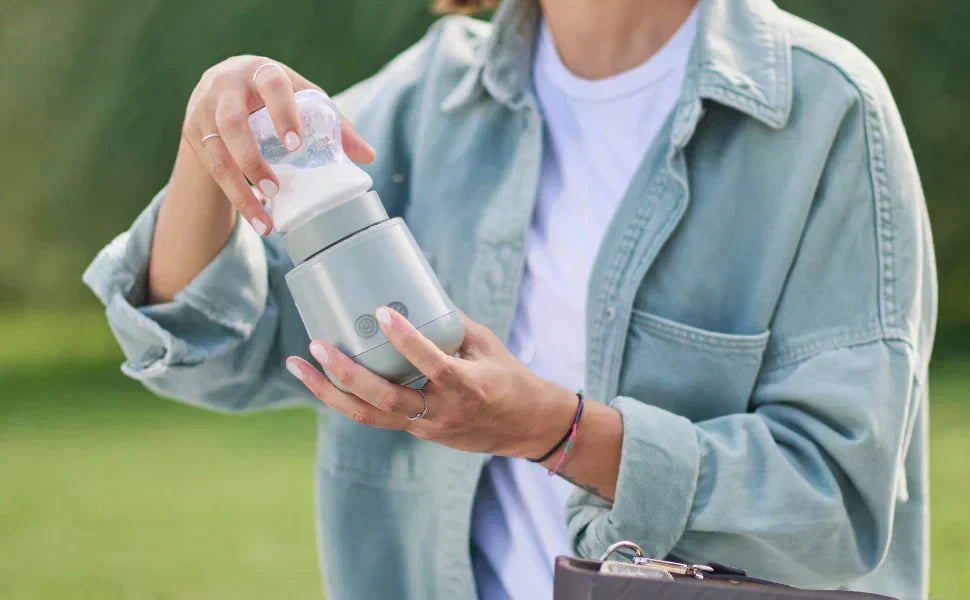Practical guide for infant formula preparation: hygiene and correct temperature

Breastfeeding is recommended by the WHO as the ideal feeding method for infants during the first six months of life. However, when breastfeeding is not possible or insufficient, formula milk becomes an essential alternative.
It is crucial to prepare formula milk safely to protect the newborn from potential infections, and the World Health Organization (WHO) and the Italian Ministry of Health recommend specific procedures.
Bacterial Risks of Powdered Milk
Formula milk in powdered form is not sterile and can contain bacteria such as Cronobacter sakazakii and Salmonella enterica. These bacteria can cause severe infections in infants, especially in premature babies or those with weakened immune systems. Cronobacter sakazakii is a particularly dangerous bacterium and can cause invasive infections such as meningitis, sepsis, and necrotizing enterocolitis, especially in premature infants or those under two months old. Infections from Cronobacter can be fatal. Salmonella is another bacterium that can contaminate powdered milk and cause salmonellosis, a severe gastrointestinal infection. Symptoms include fever, diarrhea, and abdominal cramps, and although less deadly than Cronobacter, salmonellosis may require hospitalization, especially in infants.
These bacteria multiply rapidly at temperatures between 7°C and 65°C. The longer the milk stays in this temperature range, the higher the risk of an increased bacterial load and, consequently, infections for the baby.

WHO and Italian Ministry of Health Recommendations for Preparing Bottles with Powdered Formula Milk
Hygiene
Before preparing the bottle, it is essential to wash your hands thoroughly with water and soap before touching the baby or items that come into contact with their mouth. Make sure the bottle and nipple have been thoroughly cleaned and sterilized before every use. You can use a steam sterilizer or boil the items in water for at least 5 minutes.
Water and Temperature
Use drinking water to prepare the formula milk. If the tap water is not safe, use bottled water with low mineral content.
To reduce the risk of infections, it is essential to bring the water used for reconstitution to a boil (100°C). Then, the water should be allowed to cool to no less than 70°C before adding the powder. This temperature is crucial for killing bacteria present in powdered milk, although it may alter some nutrients in the formula, such as some vitamins.
Preparing Powdered Milk
Follow the instructions on the powdered milk package carefully regarding the proportions of water and powder. Use the measuring scoop provided with the package to correctly measure the powder.
Cooling and Consumption
After preparation, the milk must be quickly cooled to 37°C. This rapid cooling is important to prevent remaining bacteria in the powdered milk from multiplying. Prepared milk, if kept at room temperature, should be consumed within two hours.
How to Do It at Home and Away
If you are at home, no problem! You have everything you need, including the ability to quickly cool the milk from 70°C to 37°C by placing the bottle under a stream of cold running water.
If you need to go out, however, you must prepare the bottle following the above rules, including rapid cooling, and then:
- If feeding is planned within 2 hours of preparation, no further precautions are necessary;
- If feeding is planned after this time, the bottle must be kept in an insulated bag with a cooling block to maintain the milk at a safe temperature (up to a maximum of 4 hours).
At feeding time, simply warm the bottle to 37°C (the same temperature as breast milk) with a portable bottle warmer like the Nuvita Warm’n’Mix with the exclusive “Warm & Mix” function, which automatically mixes the milk while it warms up. This way, the bottle reaches a perfectly uniform temperature without cold spots or air bubbles.

This is undoubtedly the officially recognized method considered the safest to warm the formula milk bottle, according to the recommendations of the World Health Organization, the Ministry of Health, and the majority of pediatricians and breastfeeding experts.
However, there are also different schools of thought that minimize the risks mentioned, considering them likely to affect only a minority of small children more prone to certain types of infections. If, as parents, you feel aligned with this line of thought, the bottle of powdered formula milk can be simply prepared with 70°C water heated at the time of preparation or using a thermos that keeps the water at that temperature.
However, if you are out, the question remains how to quickly lower the bottle's temperature to 37°C to prevent the proliferation of bacteria that might be in the formula and to ensure that the bottle reaches the right temperature for the baby without the risk of burns in the mouth.
For everyone, these rules always apply:
- Always check the expiration date of the powdered formula milk
- Store the powdered formula milk in a cool, dry place away from heat sources
- Never add sugar or other ingredients to the formula milk unless specifically instructed by the pediatrician.
In terms of convenience, liquid formula milk is a simpler and faster solution than powdered formula: it is already sterilized, and when sealed, it can be stored at room temperature. When needed, simply pour it into the bottle and warm it to 37°C, and it is ready to be consumed.
It is still essential to always consult the pediatrician for any guidance, doubts, or questions regarding your baby’s nutrition; only in this way can you be sure you are raising your child in a healthy way.





